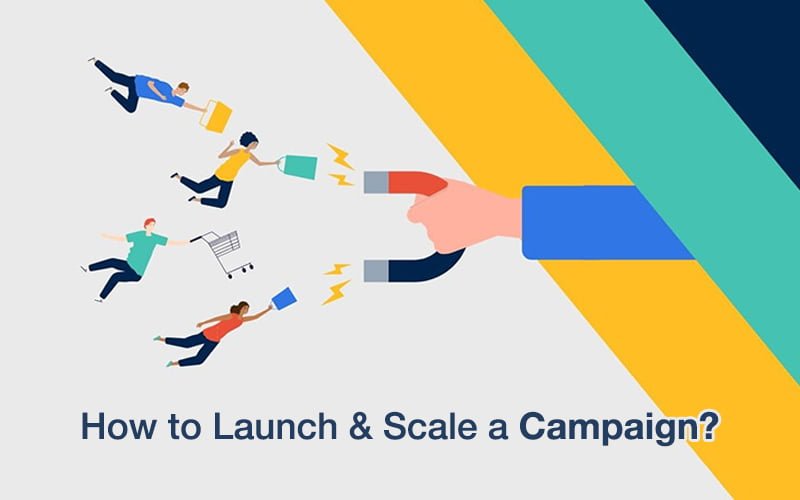Luckily, there are several things you can do to set yourself up for success. There are countless considerations when launching and scaling a marketing campaign: identifying your goals, understanding your target audience, planning your strategy, and deploying the necessary tactics.
To help guide you through the process, we’ve put together a few key tips to ensure your campaign is as successful as possible.
Set realistic goals:
It’s critical to have a clear understanding of what you want to achieve with your campaign and what metrics you’ll use to gauge success before you launch an Ad campaign.
If we’re promoting a clothing eCommerce shop, we’ll set a goal for how much revenue/sale we want to generate from this campaign.
Do your research and strategize:
This entails not just knowing who your target audience is, but also which platforms they prefer to use. Figure out whether you’ll market through Google Ads or social media ads. A Google ad agency can help you better while deciding the ad formats you should use in Google Ads as it has multiple options to choose from. List down the locations and the audience group you want to target. Both Google Ads and social media Ads have diverse targeting features that can help you optimize your campaign.
Decide advertising formats and the amount you want to spend on the campaign.

Work with relevant keywords:
Using the keyword research tools available, create a list of keywords that will help you target your audience. It’s also critical to create a list of negative keywords for which ads will not appear and save you from wasted clicks.
Work through both lists thoroughly to ensure that your ad is shown to the prospect willing to bring you some business.
Appealing Headlines and description
Make sure your ads stand out from the competition by using engaging headlines and descriptions that urge consumers to click on your ad over those of your competitors.
In image ads or videos, ads make sure that your graphics are eye-catching and build inquisitiveness in the audience to choose you over others.
Optimize landing pages and easy navigation
Your landing page UI should be user-friendly and easy to navigate. Your landing page should clearly state the offers or discounts you are offering. The page should be quick to load and with clear Call To Action buttons so that prospects have a positive user experience.
So you’ve been working on an ad campaign for a while and you’ve finally nailed the balance of offer, messaging, creativity, and target audience. Time and effort are required for each ad campaign that needs to be scaled. If you’re not cautious, you can end up destroying the ads and any results they brought with them.
One prime thought that pops up in our head while scaling a campaign is to increase the budget but hold your horses before you do that!
The two most common techniques to scale the budget of a campaign: Vertical scaling and horizontal scaling.
Vertical scaling involves increasing the budget in a high-performing ad set (increasing the budget in one direction), and horizontal scaling involves adding more ad sets to the campaign and expanding the audience reach.
Always keep in mind increasing the budget randomly can ruin your campaign. As the algorithms of Ad platforms take time to adjust to the changes so that they can deliver optimum results. Instead of increasing the budget in one shot, increase the budget gradually over a duration of time.

Return On Ad Spend (ROAS) is the amount of money your online business makes for every rupee it spends on ads. This is part of the smart bidding strategy introduced by Google.
Consider the following when calculating the % ROAS:
The conversion value(s) you are optimizing for
(revenue/ad spend) X 100 = ROAS.
For example, if you spend 2000 INR on a campaign that generates 6000 INR in sales, your ROAS is 300 percent.
Consider gradually lowering the Target ROAS of your advertising if you want to boost conversion value. This informs the bid strategy that you are willing to pay more for each conversion, enabling the strategy to spend more in order to improve sales and conversion value.
It’s critical to plan your desired ROAS in order to maximize profitability for your company and its aims.
Now it’s time to diversify the advertising platforms and formats. If you are running a search ad it’s time to use various ads formats like images, and videos, and if you run an eCommerce business start with shopping ads. Bring to bear the power of social media ads to increase your reach.
So far you’ve built a strong customer base using the various PPC campaigns, it’s time to bring the customer retention strategy in place. In your digital marketing plan, remarketing efforts are the crux of the matter. They’re a terrific approach for retaining the customers who saw or interacted with your ad but didn’t convert it into a lead or made a purchase. Having a remarketing strategy is blood to your business.
As you have read so far about how you can launch a campaign and also scale a campaign. It is always advisable to have an experienced PPC marketing company put up a campaign for your business so that they can handle all of the minute technicalities to run a successful ad campaign.
If you have any queries on the above tips and tricks or would like further assistance on your campaigns, don’t hesitate to reach out to us, we are happy to help you!
